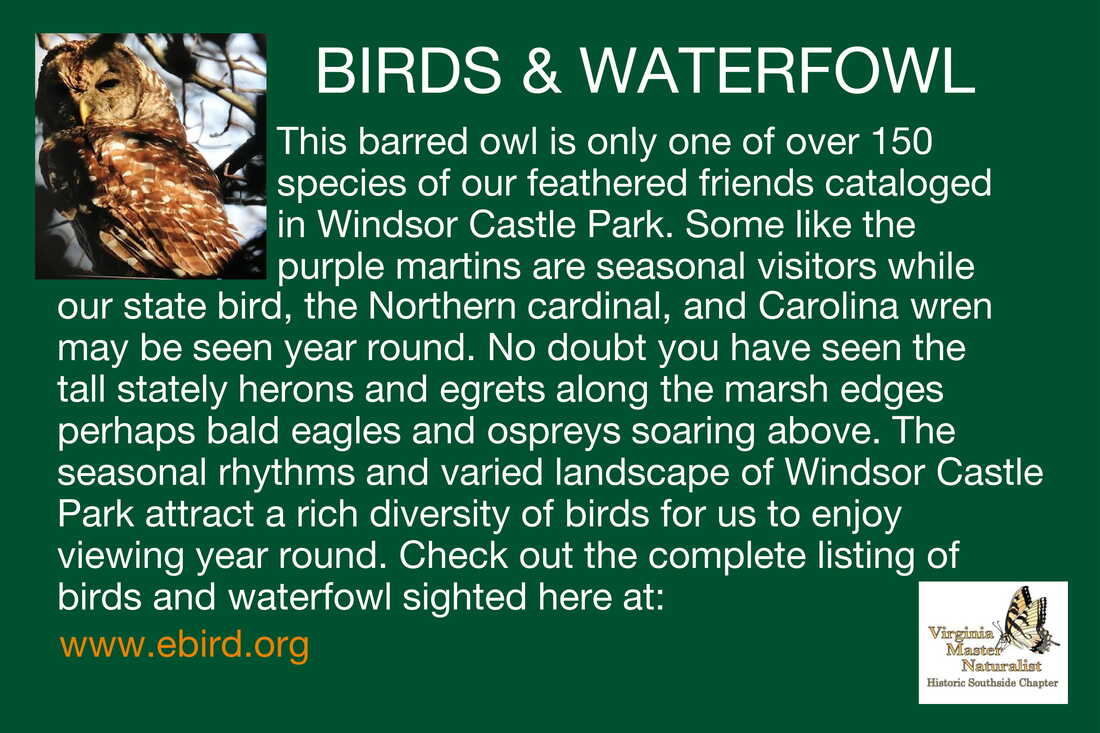Introduction
If you’re a bird, it’s all about a healthy habitat. And Windsor Castle Park is rich in diverse mature niches occupied by a wide variety of birds from the tiniest hummingbird to the grand bald eagle. The park is fortunate to have a large expanse of native marsh grasses that support the charismatic Marsh Wren, Red-winged Blackbirds, and Clapper Rails, all of which can be heard and seen from the park’s bridges if you watch carefully. Many herons inhabit the marshes as well, and the species mix can be observed to change seasonally. The great ancient oaks and pines are one of the park’s finest treasures, and hundreds of birds of all kinds depend on them daily for their food (insect, seeds and berries), shelter, and nesting places. Some of the birds you will encounter at close range include Goldfinches and sparrows, eating seeds from/in the grasses and Bluebirds and warblers gleaning insects from the young oaks that line the Windsor Castle Park trails. In the spring you will undoubtedly see ospreys and eagles as they fish in the creek and feed their young.
Some facts to consider
Select any of the other buttons to learn more about birds and waterfowl from other websites.
If you’re a bird, it’s all about a healthy habitat. And Windsor Castle Park is rich in diverse mature niches occupied by a wide variety of birds from the tiniest hummingbird to the grand bald eagle. The park is fortunate to have a large expanse of native marsh grasses that support the charismatic Marsh Wren, Red-winged Blackbirds, and Clapper Rails, all of which can be heard and seen from the park’s bridges if you watch carefully. Many herons inhabit the marshes as well, and the species mix can be observed to change seasonally. The great ancient oaks and pines are one of the park’s finest treasures, and hundreds of birds of all kinds depend on them daily for their food (insect, seeds and berries), shelter, and nesting places. Some of the birds you will encounter at close range include Goldfinches and sparrows, eating seeds from/in the grasses and Bluebirds and warblers gleaning insects from the young oaks that line the Windsor Castle Park trails. In the spring you will undoubtedly see ospreys and eagles as they fish in the creek and feed their young.
Some facts to consider
- To appreciate the great variety of birds (over 250) that have been sighted in the park and recorded go to the eBird site where they are listed and described.
- If you want to know more about birds or wish to become involved in citizen science at the park, visit ebird.org and Audubon.org. Also, make sure to check out the Virginia Society of Ornithology (virginiabirds.org), a science based organization that focuses on conservation and enjoyment of Virginia’s birds.
- Four birds that you will most likely see on a visit to the park are:
- Eastern Bluebirds – seen in open fields and wooded sections
- Great Blue Heron – seen along marshes and over the creeks
- Osprey – seen flying over Cypress Creek or nesting on platforms or tops of trees
- Red-bellied Woodpecker – seen in forested areas
Select any of the other buttons to learn more about birds and waterfowl from other websites.








